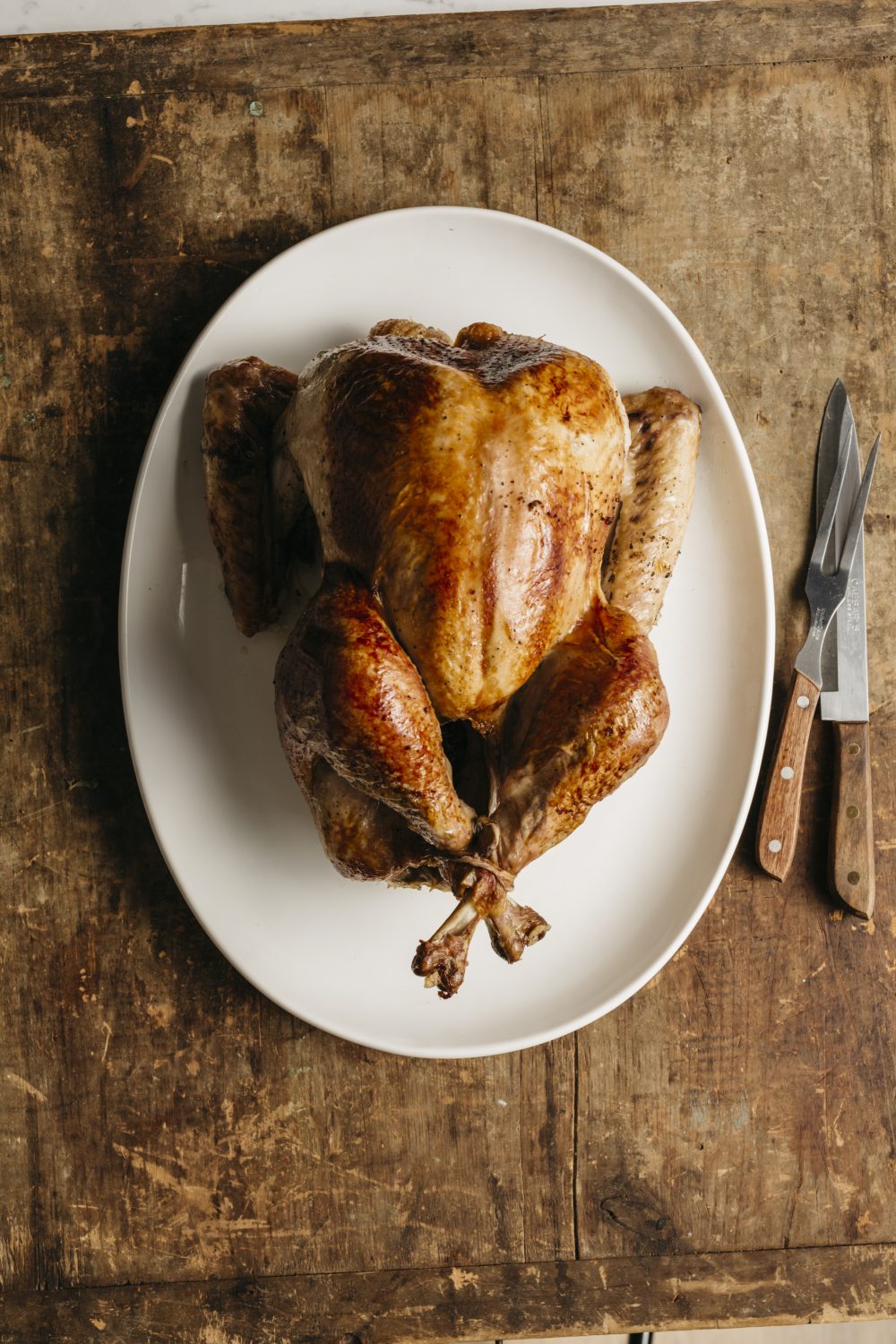Cookbook author Andrea Nguyen tells it like it is: “My family is not huge on turkey. My mom actually hates turkey's dryness and my husband never enjoyed its flavor.”
She’s not alone. Turkey tends to get a bad rap, and justifiably so—especially when compared to other favorites on the Thanksgiving table. (Can anything compete with stuffing and mashed potatoes?) Turkey is notoriously tricky to cook evenly. Chef Ed Lee of 610 Magnolia, MilkWood and Whiskey Dry in Louisville, Kentucky—a self-proclaimed Thanksgiving fanatic—distills the matter down to timing. The breasts cook faster than the legs, which means they usually dry out by the time the legs have cooked through. Flavor is also elusive and crispy skin is anything but a guarantee if you’re also aiming for juicy meat.
So we asked six of our friends how they typically cook their turkeys.
Butterfly the Bird
“When I do roast a turkey,” Nguyen says, “I butterfly a small one (like 11 pounds) and make pho with the leftovers. The dressing is based on my mom's, made with sticky rice, the turkey liver, shiitake, pork, Cognac, thyme and some other stuff. Also, we simmer chestnuts in chicken broth with butter and cilantro. The broken bits are added to the dressing.” Butterflying, or spatchcocking, is the process of flattening poultry by removing the backbone, which allows the whole bird to cook more evenly.
See here for a step-by-step guide to spatchcocking.
Add Wine to Your Brine
Nik Sharma, author of “Season,” likes to use wine when he brines. “Typically, the method that I use, I brine in a dry or wet brine and I usually splash a bit of white wine on top, because I find the wine makes the skin crispier,” he says. If he’s dry-brining, he’ll splash white wine on top of the bird before roasting, and if he’s wet-brining, he’ll use two parts wine to one part water. The spices he uses vary each year. “I find the alcohol sucks out a bit of the fat and moisture, and I just feel like the skin is crispier.”
Don’t Truss
If you aren’t spatchcocking and are going for that whole turkey presentation instead, Ed Lee warns against trussing, which limits exposed surface area. An untrussed bird will have more opportunity to get crispy from all angles. For presentation’s sake, you can tie the legs together after the turkey has cooked, Lee says.
Stuff It, But Not How You Think
We’re in favor of cooking stuffing outside the bird (see our recipe for Easy Oven-Baked Mushroom-Herb Stuffing here), but that doesn’t mean your turkey has to remain hollow.
Lee points out that filling the cavity provides extra insulation for the breasts, which should protect them from cooking too fast and drying out. “What I do is I pack it with fingerling baby potatoes, herbs, sage, rosemary and tons of salt. So now you’re still getting the flavor and you’re creating that insulation. But you’ve got to really pack it in there so nothing else will fit,” Lee says.
Cookbook author Von Diaz uses mofongo—a mixture of plantains, chicharron (pork rinds) and garlic—to stuff her turkey, while author Reem Kassis takes yet another approach. After dry brining her turkey with salt and Nine Spice Mix (recipe in "The Palestinian Table") and a bit of tomato paste, she says, “I stuff [the cavity] with something we call ‘hashweh.’ (It literally translates to ‘stuffing’ in English though, ha!) It’s a mixture of rice, ground lamb or beef, spices and pine nuts. (The recipe is also in 'The Palestinian Table' on page 166).”
Flip the Bird and Wrap It Up
Following in her abuela’s footsteps, Diaz roasts her turkey like a traditional Puerto Rican pork roast, marinating it overnight in garlic, oregano, olive oil and vinegar, before stuffing it with the aforementioned mofongo. Then she turns it upside down and wraps it in a clean cloth soaked in lard before putting it in the oven—a secret from her grandmother’s favorite cookbook, “Cocina Criolla.”
Ice the Breasts… with Herbed Butter (Stay with Us)
“I’ve always felt like you have to insulate the breasts in order for them to cook slower, so I always stuff something under the skin. Sometimes it’s bacon, sometimes it’s hash brown potatoes, which works really well. Because as you add stuff, you’re essentially creating a bigger breast, so it takes longer for that to cook,” Lee says.
This year, he plans to try something he’s done with chicken, which is putting ice cubes under the skin. The idea is to cool down the breasts so that they take longer to cook. “You’re essentially giving the legs a head start,” Lee explains. The problem here, however, is that excess water could prevent the skin from crisping, so instead, Lee plans to try freezing clarified butter and sticking that under the skin.
“I have feeling that’s going to work.” We can’t wait to find out.
Consider an Unorthodox Finishing Touch
New York City chef, restaurateur and cookbook author Seamus Mullen brines, smokes and then adds a sweet and sour kick to his bird. “I like to brine the bird in 10 percent brine with juniper, coriander, orange and rosemary, then slow smoke it in my Traeger smoker, season with salt and pepper and spray it with a mixture of pomegranate molasses and white balsamic vinegar.”
Check out the pomegranate molasses and white balsamic vinegar we love.




